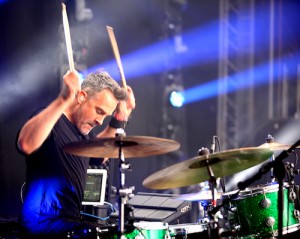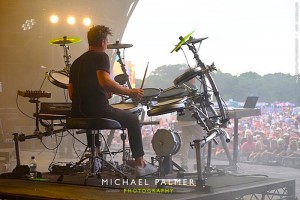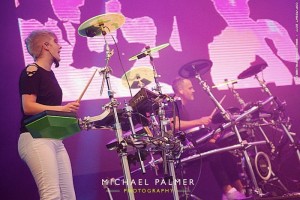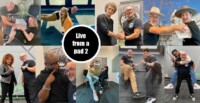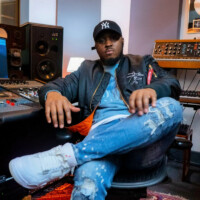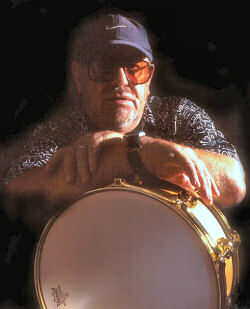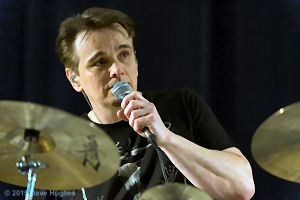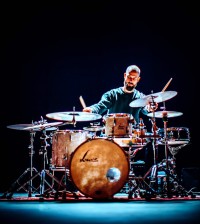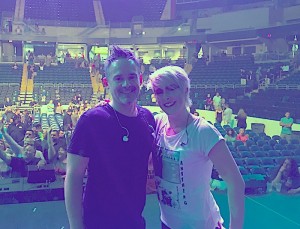 What could possibly be better than having a drummer on stage?
What could possibly be better than having a drummer on stage?
You guessed right: Two drummers!
And what better combination could there be than the UK’s very own Emily Dolan Davies and Jonathan Atkinson.
Both successful session musicians in their own rights, Emily (The Darkness, Tricky, Cher Lloyd) and Jon (Rick Astley, The Supremes and many others; plus soundtracks including Paddington 2, Johnny English 3, Doctor Who and Inside Number 9) have joined forces to create a solid and groovy backdrop for not one but two touring artists.
With Kim Wilde as well as Howard Jones, the duo are sharing stages all over Europe splitting acoustic drums, percussion and electronic drums over their 8 skilled limbs.
I caught up with Emily and Jon before their soundcheck in London to chat about how the double drummer set up came about, the benefits and challenges associated with it and what else the two are up to when they’re not sharing a stage.
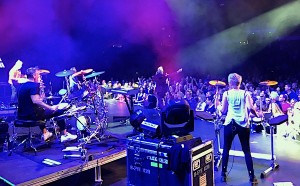 How did the ‘double-drummer relationship’ come about?
How did the ‘double-drummer relationship’ come about?
Emily:I was playing with Tom Bailey on an America tour and Jon was playing with Howard. We had actually met about seven years ago through a mutual friend and just got on super well. When I found out Jon was on the gig I thought: Amazing, we finally get to tour together. Obviously it hardly ever happens that you get to tour with another drummer. We just hit it off and kept in touch. Howard’s tour manager is my now husband, so I was kind of always around anyway. Then one day Howard approached me and asked how I would fancy to add to the existing line up.
Jon:It’s an interesting one with Howard: I’ve been with him for about 10 years now and when I joined, it was a really big band. It was all quite rocky and I was playing acoustic kit. From there it went through various different permutations with brass, choirs and all kinds of things. In 2010 he decided that he wanted to do a complete recreation of his first two albums – in a way only Howard can by setting quite specific rules on how it was gonna work. It was decided to play these two albums as a 3-piece: myself, Robbie Broniman playing keys and dealing with Ableton, and Howard playing a crazy amount of keys. We did this small set up for about 6/7 years but it’s now slowly expanding again – which is lovely. As much as I love having stuff on track, being quantised and the ultra precision we were going for, it’s also nice to now have guitar and Emily with us. It has certainly added a lot of energy on stage.
Howard Jones has continuously released albums from the early 80s till today and has thereby covered a lot or eras of music. Is it a big challenge to cover all the changes in music and sounds over all those years?
Jon:Yes, certainly in the 80s he was very much a fixture of the British music scene. For example he was involved in the Prince of Wales Trust gigs every year. It was quite a big event and it was pretty much the same band every time: Phil Collins on drums, Mark King on bass, Eric Clapton on guitar, Elton John and Howard on keys and whoever joined in on vocals. Watching those gigs was sort of when I decided I wanted to be a musician.
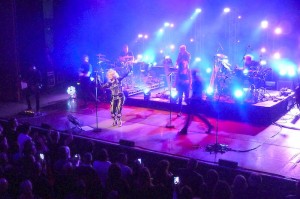 Emily:I think he has always been one to be at the forefront pushing whatever technology was about, and he’s still like that now. Some of the gigs are really on knife’s edge whether it’s gonna work or not because the technology is so out there.
Emily:I think he has always been one to be at the forefront pushing whatever technology was about, and he’s still like that now. Some of the gigs are really on knife’s edge whether it’s gonna work or not because the technology is so out there.
Jon:He has this ethos that if something can be done, even if it’s only in theory and nobody has ever done it, we should try and do it – which is great.
When we started touring his first two albums the rule was that all the sounds we played had to have originally existed on the 2-inch tape. That meant us getting the tape transferred to digital, remixing it so it would sound like on the record and then lifting individual samples out of that and making it playable. That was a years worth of work. Some of the keyboard sounds Howard is playing, only on tape ever existed as chords. We had to use Melodyne to lift individual notes out of that and loop them… it was a proper mission.
You guys are not only doing the Howard Jones gig at the moment but you’re also touring with Kim Wilde. It must be hard to juggle it all.
Jon:Yes, this is actually a nice week: we’ll have had two gigs with Kim and a mid-week one with Howard. It’s great that they just about jigsaw together like this.
 Emily:It really can be difficult politically because it’s all that 80s crowd where everyone knows each other. You have to be careful not to upset anyone.
Emily:It really can be difficult politically because it’s all that 80s crowd where everyone knows each other. You have to be careful not to upset anyone.
Jon:In the last year we’ve done about 70 gigs with Howard, whereas this year it’s more like four – but we’re doing about 50 with Kim. We’re both just so lucky that it worked out like this.
Jon, you’ve done the Kim gig by yourself for quite a while. How do you then approach ‘sharing’ the parts?
Jon:It’s interesting, and it was quite different from how we approached it with Howard. On Howard’s gig there was a lot of percussion stuff running on track that Emily is now covering.
Emily:Yes. And stuff that Jon hated playing.
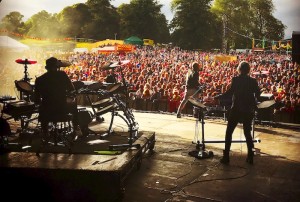 Jon:That’s very true. There was a lot of “I hate playing that – Emily, you play it”. That worked really well. It was a different thing with Kim because it had only been acoustic drums and a little bit of electronics for a long time and there is less stuff on Kim’s records, so it took a bit of thought. There were some very obvious things for Emily to play but on other occasions we really had to think about how to do it to actually add to the show.
Jon:That’s very true. There was a lot of “I hate playing that – Emily, you play it”. That worked really well. It was a different thing with Kim because it had only been acoustic drums and a little bit of electronics for a long time and there is less stuff on Kim’s records, so it took a bit of thought. There were some very obvious things for Emily to play but on other occasions we really had to think about how to do it to actually add to the show.
Emily:That’s the thing, it’s all about balance. It’s hard enough to be a drummer and not overplay on a song, two drummers not overplaying on a song…
Jon:I think we’re quite good at leaving space for each other though.
Emily:Oh definitely. I think that’s because we got on so well. We have a lot of respect for each other and there is no ego there. I’ve done other double drummer things and the ego thing has definitely played a part. That’s just tedious; whereas this is just so much fun.
Jon:We definitely have a laugh and there is little bit more freedom on that on Kim’s gig I guess. There are some moments on Howard’s gig but there is also such a tight framework to the show.
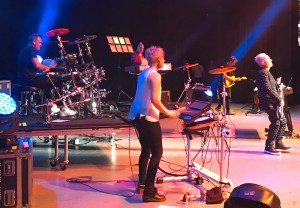 How did you slip into the Kim gig then Emily?
How did you slip into the Kim gig then Emily?
Emily:That was a funny story. We were on the Howard tour and a couple of gigs came in for Kim because Jonny has been Kim’s drummer for the last 15 years. He asked me if I would be able to cover them for him and of course I was up for it. I meticulously went through the parts and made sure that I would sound exactly like Jonny so they don’t even realise he’s not there. That’s basically my aim whenever I’m depping for anything. The gig seemed to go well and I got on with them really well. After the gig Kim said: “I really enjoyed playing with you”; and jokingly I went: “Ha! You’ll just have to have two drummers now.” and she went: “That’s a great idea!”. Her manager is also her front-of-house engineer and I could see him looking at me with a ‘I’m going to kill you’ look on his face. That’s how it came about.
Jon:It just became a ‘this is gonna happen, we just need to work out how we’re gonna make it work’. It’s really good and it has taken what Kim was doing already and moved it up yet another nudge.
Emily, was there ever a worry about “stepping on someone’s toes” coming in as the ‘additional’ drummer?
Emily:Oh absolutely! That was on the forefront of my mind. My number one thing was: I don’t want to step on anyone’s toes – and that’s not just with Jon but also Robbie who does all the Ableton stuff. I didn’t know what he was maybe already triggering. I started out the conversation sort of tiptoeing around but Jon just went: “I don’t care. I don’t want to play this, can you play that?!”. I also had a conversation with Robbie and it all just kind of worked. I had seen Howard play about 30 gigs before I joined so I sort of knew the songs and arrangements but going back listening to the music I noticed how much stuff actually was on the original tracks that wasn’t covered live.
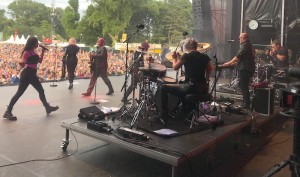 I did the same thing for Kim’s gig and actually when I was playing something in rehearsals Ricky – who’s Kim’s brother, guitarist and has written most of her songs – would turn around and go: “Oh yeah, I had forgotten that was on there”!
I did the same thing for Kim’s gig and actually when I was playing something in rehearsals Ricky – who’s Kim’s brother, guitarist and has written most of her songs – would turn around and go: “Oh yeah, I had forgotten that was on there”!
Jon:It can sometimes be quite subtle stuff but it really makes a difference.
Let’s talk rigs a little bit. I’m guessing you both have fairly different set up’s from each other?
Jon:My rig for Kim’s gig has gone through a fairly hefty evolution over the years but now I’m mainly on acoustic drums. I also use a Yamaha DTX M12 and run a kick and a snare trigger with it, and it also controls Ableton. That’s sort of it. It’s fairly simple and straight forward.
Howard’s set up is a little more complex. I went through a stage of using a TD 20 and MainStage but it was just so unreliable. When Emily joined we had the opportunity to draw a line under that set up and do a complete rebuild of the rig, so I started using the DTX 900 which has been an improvement in every respect. As much as I love the ease with which you can make quick changes in Main Stage, it’s simply not ready to be used on big stages.
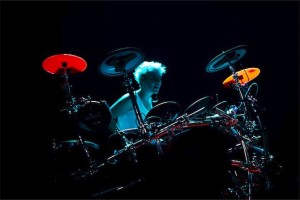 Emily:My rigs are very simple comparatively. For Kim it’s essentially an acoustic kit in as much as me having two toms, the rest of it is acoustic percussion and a few electronics. It’s based on the Yamaha M12, so my approach had to be ‘how many external pad can I have and where do I need to put them to execute all these songs’? Also there’s an element of where to put them so it looks good. Maybe that’s wrong but if I can play outwardly with big movements, it’s gonna look better than being crouched over a little multi pad.
Emily:My rigs are very simple comparatively. For Kim it’s essentially an acoustic kit in as much as me having two toms, the rest of it is acoustic percussion and a few electronics. It’s based on the Yamaha M12, so my approach had to be ‘how many external pad can I have and where do I need to put them to execute all these songs’? Also there’s an element of where to put them so it looks good. Maybe that’s wrong but if I can play outwardly with big movements, it’s gonna look better than being crouched over a little multi pad.
That was the initial thinking on Howard’s rig as well. For that gig I’m completely electronic mixing the Multi 12 with Simmons pads and all sorts of other stuff. A big part of me coming onto that gig was him asking me if I was ok with play standing up – so I knew I would have to add a bit of a performance element to it. I’m mainly using bigger external pads so I can play more freely than trying to hit a tiny square pad all the time. That influences my programming too of course.
Jon:Well the thing with Howard’s gig generally is that quite a lot of the audience won’t know the level of technology that’s going on. You don’t want the audience to think they could just put it all on a CD and it would be the same, so there needs to be that element of performance. I was using the TrapKat for a while, which basically meant I was sitting behind a table playing with tiny motions. The bigger rig now just really adds to the show. Also if people who are maybe not that musically minded are watching the show and they can see a big movement that ends up with a clap sound, they can actually attach that with each other.
There is actually a funny story to this. When I used the Trap Kat my feet were on view which are normally covered by a bass drum. On the first tour we did with it a lot of people seemed surprised that I was playing things with my feet. Yes, of course. As every other drummer too. People didn’t know that but I thought it’s fair enough that the audience might not know how drums work. So for the next tour I got a pair of luminous green shoes and I have literally never heard so many comments about my feet. We did some TV shows and no matter what I played, there was always a camera man filming my feet. The interest in it was crazy! There is such a disconnect. People just don’t get what you do as a drummer generally, even less so when you’re playing electronic drums.
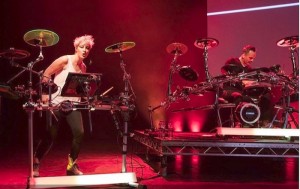 Do you guys do your own programming?
Do you guys do your own programming?
Emily:Oh yeah absolutely. I don’t think I’ve ever gotten anyone to do my programming. We both are such control freaks, I wouldn’t dare letting anyone else do it. I remember doing an audition for a band that Andy Gangadeen had put together, so he had done all the programming already. I turn up and there was one of his classic big set ups. He went: “Right, this sample is on here, this one there and you have to play it like this…”. It’s like getting into someone’s brain and it really through me off. It was fine in the end but I definitely decided to always do my own programming.
The trickiest part of playing electronic drums anyway is remembering where everything is. It might make sense to one person but not work for the other. Prime example is that Jon is leading with his left hand a lot. I had to cover for him on the Howard show and some of the stuff was really hard to play because of that.
Let’s chat about you individually a little.
Emily, your last longer engagement was with The Darkness. How does it compare coming from such a crazy, full-on Rock band to a Pop gig now where you have to stick to your parts much more?
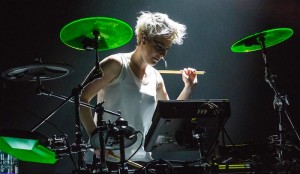 Emily:It’s funny you say that because yes, The Darkness is a band, but coming in replacing another drummer who had been there for so long I was still learning all his parts and how he had played it. I thought I need to be myself but at the same time respect his parts because: A. They’re on all the records; B. The fans love them; and most importantly C. The band had played with him so long, they were used to them. I didn’t wanna come in and change the whole vibe. Live, to be honest, I’d say the energy is not that different on Kim’s gig now. There are a couple of odd moments where The Darkness was more energetic, but then they weren’t as energetic as when I played with Tricky. The energy on that gig floors everything just because you have half of the audience on stage.
Emily:It’s funny you say that because yes, The Darkness is a band, but coming in replacing another drummer who had been there for so long I was still learning all his parts and how he had played it. I thought I need to be myself but at the same time respect his parts because: A. They’re on all the records; B. The fans love them; and most importantly C. The band had played with him so long, they were used to them. I didn’t wanna come in and change the whole vibe. Live, to be honest, I’d say the energy is not that different on Kim’s gig now. There are a couple of odd moments where The Darkness was more energetic, but then they weren’t as energetic as when I played with Tricky. The energy on that gig floors everything just because you have half of the audience on stage.
I think every gig is different. It’s just finding the things that you really enjoy about them and pride yourself doing. With Howard it’s all about precision and performance. With Kim it’s definitely the energy and the vibe on stage; me and Jon are having an absolute ball!
You also have your own studio from where you offer remote recordings?
Emily:Yes I do. When I parted ways with The Darkness in May of 2015. I thought nobody is gonna call me for the rest of the year, so I sat down and had a think about what I really love about drumming. I realised I love the variety, playing with loads of different people and I actually quite enjoy being at home as well. What would be a nice situation to combine all of this? Remote recording. That was two years ago and people really seem to want the service. I’m concentrating on that a lot outside of touring and it’s working out very well this summer as we’re doing festivals on the weekends and I’m at home during the week to record. I always went a bit crazy when I was off tour at home thinking I should be doing something all the time. With this I feel I have some control over it, it keeps me occupied and keeps me from killing the husband.
Jon, you do a lot of programming. Just for the artists you play for or for other acts as well?
Jon:Yeah I do. It varies a bit but programming is where I started out really – and maybe is what I’m more known for. I was always fully into electronics from age 15 with an MPC60 and that side of things. That was sort of my way in when I first moved to London.
You also compose for TV and film. Has that always been a passion?
Jon:Yes. I’ve just done my first game score which was great.
Yeah I think so. I started out as a pianist when I was four and later played trumpet for a while. I love the orchestral side of things but was never particularly gifted at it so when I started playing drums I also had classical percussion lessons so I could stay in the orchestras I had been in. I sort of see the composing as an extension of that love of both classical and film music. I really enjoy it.
In the last year I’ve also started working with a couple of guys making content for Loopmasters and Novation. We’re doing not only drum loops but also percussion and synth stuff. It’s really good fun and it’s doing surprisingly well.
Emily:He’s had some massive success with it. Stop being so humble.
Jon:[laughs] I really enjoy that and it’s quite interesting to create the tools for other people to create with.
Emily:Whenever we’re in a venue he’ll be in the dressing room with his OP1 going: “Listen to this, I just sampled you making a cup of tea!” And it actually sounds amazing! Your some kind of magician, I can’t even get my head around it.
Jon:Being part of creating a sound really is an extension of what we do as drummers when we’re tuning our kit, or your decision how dead you’re gonna make your snare drum to fit in with the vocal on a track. I just love extending beyond that into making interesting sounds. I’d love to have an opportunity to do that on site for people maybe in the film world. I do love writing film scores and I get to play drums on quite a few films but I’m really curious about the sound design side of it.
Finally, what’s next?
Emily:As a duo we’ve got festival all over summer with Kim, a few with Howard and about three European tours towards the end of the year. We’re basically busy up till December.
Other than that for me it’s all studio stuff. I’m actually really surprised how well it’s going, which is great.
Jon:More of the same for me really. More writing. I’m doing a TV show at the moment, have a film I’m working on and another game towards the end of the year as well; and more Loopmasters, which is great. It’s all very fun!
Thanks a lot for your time guys! Have a great summer of touring!
Interview by Tobias Miorin
July 2018

